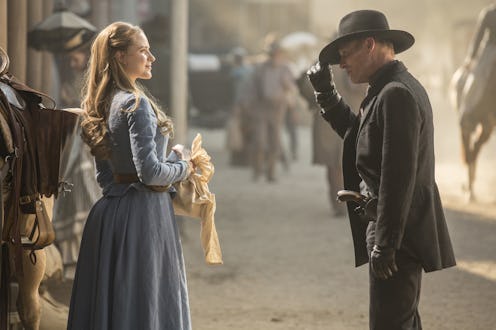
HBO's newest original series is rather complicated in its labyrinthine mythology, but the actual rules of Westworld are relatively straightforward: the human "guests" can pretty much do whatever the heck they want, while the robot "hosts" are not allowed to harm the humans. It's the single cardinal rule of the park — never kill a guest — and yet it can get somewhat confusing when it's hard to tell the difference between the flesh and blood customers and the mechanical attractions. So the question of which Westworld characters are robots and which are actually human will undoubtedly be a crucial one moving forward.
Part of the confusion stems from the fact that the writers set up some clever misdirect in the pilot surrounding two of the show's central characters. From what the trailers seemed to imply and the opening scenes of him arriving in Sweetwater on the train, I'm sure many viewers assumed that James Marsden's character Teddy Flood was a guest involved in some human/robot Romeo & Juliet romance with Evan Rachel Wood's character Dolores Abernathy. But when Teddy was killed 15 minutes into the episode — and then promptly reawoke on the train again the next morning — it was clear that the handsome gunslinger was far less human than he initially appeared.
Westworld's promotional material also pulled the wool over our eyes when it came to the true nature of Ed Harris' character, the mysterious Man in Black. Most viewers who are familiar with the 1973 film on which the show is based (written by Jurassic Park author Michael Crichton) probably recognized that Harris was being set up as HBO's version of that movie's villain, the black-clad character played by Yul Brynner known simply as "The Gunslinger," a robot that malfunctions and homicidally pursues the protagonist throughout the titular park. But in his encounter with Teddy, it was revealed that the Man in Black is actually a human guest who has been visiting the park on-and-off for 30 years and — having played through all of its narrative possibilities multiple times — is now looking for a deeper level to the "game."
Thankfully, other than those two cases of misdirect, the rest of the man vs. machine breakdown is relatively simple. Other than the Man in Black, every important character we've met in the park itself is a robot; that includes Dolores, Teddy, madam Maeve (Thandie Newton), sex worker Clementine (Angela Sarafyan), and outlaw Hector Escaton (Rodrigo Santoro). Conversely, anyone we see working behind-the-scenes in the park's underground bunker is presumably a human; including creator Dr. Ford (Anthony Hopkins), programmers Bernard (Jeffrey Wright) and Elsie (Shannon Woodward), operations manager Theresa Cullen (Sidse Babett Knudsen), narrative director Lee Sizemore (Simon Quartermain), and head of security Ashley Stubbs (Luke Hemsworth).
I say "presumably" because, come on: this is a show about robots that are so advanced they are indistinguishable from humans. It will be severely disappointing if the entire series goes by without at least one huge twist where a character we thought was a human turns out to actually be a robot. (Personally, I'd put my money on Stubbs because let's be real, the Hemsworth brothers were all created in a lab anyway.)
The matter of man vs. machine is relatively simple right now, since we haven't really spent any time getting to know many of the park's guests. It will probably get harder and harder to keep everything straight once the show starts throwing more characters into the mix moving forward, like Jimmi Simpson's first-time visitor William and his repeat customer friend Logan (Ben Barnes), both introduced in this Sunday's episode. But as William's guide says when he asks her if she's real in the show's teaser trailer, "If you can't tell, does it matter?"
Actually, I imagine that it matters a great deal to the park's human visitors, who would be severely bummed out if anyone mistook them for a robot and shot them dead. Thankfully, there are safeguards in place to keep that from happening. In the film, all the guns in the park have heat sensors that won't allow them to be fired at anything living. However, the show's writers wanted their guests to be able to be shot at — but not actually killed — so in this case "it's not the guns, it's the bullets," as creator Jonathan Nolan told Rotten Tomatoes:
In the original film, the guns won't operate guest-on-guest, but we felt like the guests would want to have a more visceral experience here. So when they're shot it has sort of the impact. They're called simunitions. The U.S. military trains with rounds like the ones we're talking about. But there's a bit of an impact, a bit of a sting. So it's not entirely consequence-free for the guests.
These bullets have very little effect on the human guests, but when they come in contact with a robot host, they initiate a programmed response that simulates a gunshot wound. So while it may sometimes be very hard for viewers to tell the difference between man and machine in Westworld, at least the bullets always can.
Images: John P. Johnson/HBO (3)